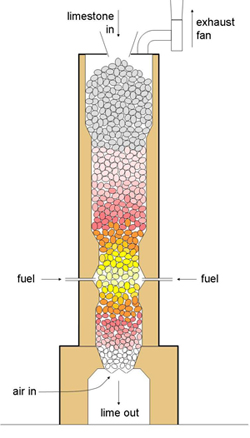Description of various kilns
Cross section of simple shaft kiln

Shaft kilns
The theoretical heat (the standard enthalpy) of reaction required to make high-calcium lime is around 3.15 MJ per kg of lime, so the batch kilns were only around 20% efficient. The key to development in efficiency was the invention of continuous kilns, avoiding the wasteful heat-up and cool-down cycles of the batch kilns. The first were simple shaft kilns, similar in construction to blast furnaces. These are counter-current shaft kilns. Modern variants include regenerative and annular kilns. Output is usually in the range 100-500 tonnes per day.
Counter-current shaft kilns
The fuel is injected part-way up the shaft, producing maximum temperature at this point. The fresh feed fed in at the top is first dried then heated to 800°C, where de-carbonation begins, and proceeds progressively faster as the temperature rises. Below the burner, the hot lime transfers heat to, and is cooled by, the combustion air. A mechanical grate withdraws the lime at the bottom. A fan draws the gases through the kiln, and the level in the kiln is kept constant by adding feed through an airlock. As with batch kilns, only large, graded stone can be used, in order to ensure uniform gas-flows through the charge. The degree of burning can be adjusted by changing the rate of withdrawal of lime. Heat consumption as low as 4 MJ/kg is possible.
Regenerative kilns
These typically consist of a pair of shafts, operated alternately. In shaft A, combustion air and fuel are added near the top and pass downward, cross to shaft B and pass upward to exhaust. The direction of flow is reversed periodically (typically 5-10 times per hour). The cycling produces a long zone of constant, relatively low temperature (around 950°C) that is ideal for lime quality.
Annular kilns
These contain a concentric internal cylinder. This gathers pre-heated air from the cooling zone, which is then used to pressurize the middle annular zone of the kiln. Air spreading outward from the pressurized zone causes counter-current flow upwards, and co-current flow downwards. This again produces a long, relatively cool calcining zone.
Rotary kilns
Rotary kilns started to be used for lime manufacture at the start of the 20th century and now account for a large proportion of new installations. The early use of simple rotary kilns had the advantages that a much wider range of limestone size could be used, from fines upwards, and undesirable elements such as sulfur can be removed. On the other hand, fuel consumption was relatively high because of poor heat exchange compared with shaft kilns, leading to excessive heat loss in exhaust gases. Modern installations partially overcome this disadvantage by adding a preheater, which has the same good solids/gas contact as a shaft kiln, but fuel consumption is still somewhat higher. In the design shown, a circle of shafts (typically 8-15) is arranged around the kiln riser duct. Hot limestone is discharged from the shafts in sequence, by the action of a hydraulic "pusher plate". Kilns of 1000 tonnes per day output are typical.
Up page:Industrial use of crusher
- Introduction of gold trommel machine
- Mill balls and water influence the effic
- Fault handling of jaw crusher
- process of Stone Aggregates produced by
- How to maintain ball mill with the lubri
- China mining machinery need technology i
- How to choose jaw crusher--let me help y
- Domestic Mining Machinery Trends brief a
- The future development trends and prospe
- The development of ball miller feeding
- Songling advise for the purchase skills
- Mining mechanization hot ascension of Mi
- The property of Flotation Machine
- The Most Important Factor in the Process
- Obvious advantages of ball mill
- Environmental Protection Idea must be st
- The Benefits of central bank cutting int
- Stone production industry promote the c
- The future of the drying equipment in Ch
- Rock Crusher Maintenance

 Jenny
Jenny